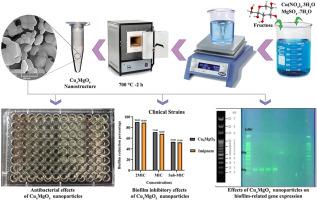Novel Cu4MgO5 nanoparticles: Investigating anticancer, antibacterial, anti-biofilm, and fimH gene-related biofilm inhibition in Uropathogenic Escherichia coli
IF 4.9
3区 医学
Q1 PHARMACOLOGY & PHARMACY
Journal of Drug Delivery Science and Technology
Pub Date : 2025-09-03
DOI:10.1016/j.jddst.2025.107481
引用次数: 0
Abstract
Uropathogenic Escherichia coli is the primary cause of urinary tract infections (UTIs). The fimH gene, which encodes an adhesin on type 1 pili, facilitates UPEC colonization and biofilm formation. Due to the high prevalence of UPEC-associated urinary tract infections and the increasing antibiotic resistance related to UPEC, the need for new therapeutic strategies is crucial. This study aimed to design and synthesize novel Cu4MgO5 nanoparticles, investigate anticancer activity, antibacterial and antibiofilm effects, and inhibition of the fimH gene on UPEC. In this study, Cu4MgO5 nanoparticles were synthesized via sol-gel auto-combustion method, and their properties were characterized using XRD, FT-IR, EDX, SEM, TEM, and zeta potential analyses. Characterization showed a pure Cu4MgO5 phase at 700 °C with spherical-like morphology (average size: 172.84 nm) and a zeta potential of −14.9 mV, indicating moderate colloidal stability. Based on results, the nanoparticles showed anticancer activity against HTB-5 bladder cancer cells (IC50 = 96.33 μg/mL at 24 h; 32.41 μg/mL at 48 h), and low toxicity to HDF normal cells (IC50 = 1039 μg/mL at 24 h; 624 μg/mL at 48 h). Antibacterial activity of the nanoparticles was assessed by minimum inhibitory concentration (MIC) test and the broth microdilution method. Based on the results, the MIC values of nanoparticles were 7.81–31.25 μg/mL against fifteen clinical isolates of UPEC that were recovered from hospitalized UTI patients and the standard E. coli ATCC 25922 isolate. At sub-MIC concentrations, Cu4MgO5 nanoparticles reduced UPEC biofilm formation by an average of 53 % and downregulated expression of biofilm-associated fimH gene by an average of 72.9 % (a 3.68-fold reduction) in both clinical and standard isolates. These findings demonstrate the potential of novel Cu4MgO5 nanoparticles as a promising therapeutic approach for managing UPEC-associated UTIs by targeting bacterial growth and biofilm formation. However, further in vitro and in vivo studies are necessary.

新型Cu4MgO5纳米颗粒:研究尿路致病性大肠杆菌的抗癌、抗菌、抗生物膜和fimH基因相关生物膜抑制作用
尿路致病性大肠杆菌是尿路感染(uti)的主要原因。fimH基因编码1型菌毛上的粘附素,促进UPEC定植和生物膜的形成。由于UPEC相关尿路感染的高患病率和UPEC相关抗生素耐药性的增加,需要新的治疗策略是至关重要的。本研究旨在设计和合成新型Cu4MgO5纳米颗粒,研究其抗癌活性、抗菌和抗生物膜作用以及fimH基因对UPEC的抑制作用。本研究采用溶胶-凝胶自燃烧法合成了Cu4MgO5纳米颗粒,并利用XRD、FT-IR、EDX、SEM、TEM和zeta电位分析对其进行了表征。表征表明,在700°C下,纯Cu4MgO5相具有球形形貌(平均尺寸:172.84 nm), zeta电位为- 14.9 mV,具有中等的胶体稳定性。结果表明,纳米颗粒对HTB-5膀胱癌细胞具有抗肿瘤活性(24 h IC50 = 96.33 μg/mL, 48 h IC50 = 32.41 μg/mL),对HDF正常细胞具有低毒性(24 h IC50 = 1039 μg/mL, 48 h IC50 = 624 μg/mL)。采用最小抑菌浓度(MIC)试验和肉汤微量稀释法测定纳米颗粒的抑菌活性。结果表明,纳米颗粒对15株UPEC临床分离株和标准大肠杆菌ATCC 25922分离株的MIC值为7.81 ~ 31.25 μg/mL。在亚mic浓度下,Cu4MgO5纳米颗粒在临床和标准分离株中平均减少了53%的UPEC生物膜形成,平均下调了72.9%的生物膜相关的fimH基因表达(减少了3.68倍)。这些发现证明了新型Cu4MgO5纳米颗粒通过靶向细菌生长和生物膜形成来治疗upec相关uti的潜力。然而,进一步的体外和体内研究是必要的。
本文章由计算机程序翻译,如有差异,请以英文原文为准。
求助全文
约1分钟内获得全文
求助全文
来源期刊
CiteScore
8.00
自引率
8.00%
发文量
879
审稿时长
94 days
期刊介绍:
The Journal of Drug Delivery Science and Technology is an international journal devoted to drug delivery and pharmaceutical technology. The journal covers all innovative aspects of all pharmaceutical dosage forms and the most advanced research on controlled release, bioavailability and drug absorption, nanomedicines, gene delivery, tissue engineering, etc. Hot topics, related to manufacturing processes and quality control, are also welcomed.

 求助内容:
求助内容: 应助结果提醒方式:
应助结果提醒方式:


